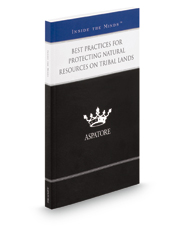Many Native American tribes still control vast areas of land, water, and other natural resources, such as oil, natural gas, timber, and fisheries. The sovereignty that drives tribal political and economic self-determination also calls for tribes to protect their land and natural resources.
Best Practices for Protecting Natural Resources on Tribal Lands provides expert guidance in pursuit of these protections and focuses on the following issues, among others:
- An overview of Indian water rights settlements by examining the historical conflicts that gave rise to the judicial recognition of Indian reserved water rights and the decades-long litigation that resulted from tribes attempting to determine the extent of their water rights
- “Treatment as State” (TAS) provisions in certain federal environmental laws that give Native American tribes the same standard-setting, certification, and permitting authority as states to administer federal environmental programs
- Protection of tribal sovereignty in the area of natural resources protection, through the examination of the most important challenges facing tribal sovereignty in a time of increased scrutiny by the U.S. Supreme Court
- Treaties that protect three important tribal rights, including a share of the catch in tribal waters; assurance that tribes cannot be displaced from areas where they have historically caught fish; and whether these treaties may lead to an even broader interpretation (currently being litigated in the Ninth Circuit)


